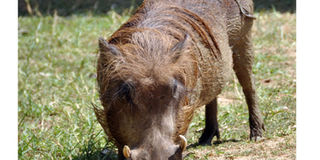Warthog: No beauty but still attractive

What you need to know:
Given its facial appearance, the warthog does not count among the world’s most physically beautiful animals, yet it is a tourist attraction, nevertheless.
With its tail standing straight, it proudly runs through the Savannah grasslands of the park. The warthog is one of the attractions in most Ugandan national parks, first for its looks, which only a mother would love, and then for the fact that it always enjoys teamwork.
It is not only in Uganda that the warthog is a spotted attraction. It is a treasured wild gem in Kenya too. At Masai Mara, the guide who takes us around, considers the ugly member of the pig family his favourite animal.
“They are cousins to the pigs and they are more cheerful than your conventional pig,” John Watua says, jokingly. But that is a fact stated by National Geographic, one of the largest non-profit scientific and educational institutions in the world.
It confirms, “Warthogs are members of the same family as domestic pigs, but present a much different appearance. These sturdy hogs are not among the world’s most aesthetically pleasing animals - their large, flat heads are covered with ‘warts’, which are actually protective bumps.”
Wildlife enthusiast Paul Janssen on his website, Out of Africa, explains that warthogs are found in most of Africa, south of the Sahara and are widely distributed in East Africa.
They are the only pigs able to live in areas without water for several months of the year.
“Warthogs sleep and rest in holes, at times they line with grass, perhaps to make them warmer. Although they can excavate, warthogs normally do not dig holes, but use those dug by other animals, preferably aardvarks,” he observes.
One of the features that are outstanding on these wild pigs are their four sharp tusks that sit on the head of sparse hair, on the sides and in between the eyes. The tusks also act as defence tools when they are attacked. They appear strong and sharp that they would easily penetrate human skins.
Unless disturbed and irritated, these spotty chaps like minding their business of enjoying their wild home, of open grasslands and bushes, through which they run in search for grass and plants to feed on.
And the way they feed is interesting too. Call it humble or disciplined, but by nature, they like kneeling, sitting on their short front legs as they reach down with their snouts to eat grass or plants. When a stranger appears, mostly tourists, they will stop feeding and move on, to distance themselves, and continue feeding.
According to Watua, warthogs can run at a speed of approximately 50 kilometres per hour. He adds that they love cooling off in low level waters, not necessarily swimming, but simply lying in the water.
In Murchison Falls National Park, after a morning of downpour, two warthog lovers lay under the sun after a bath in nearby pothole of water. One rests its head on another, providing a good Nikon moment. Just like in humans, the results of such moments is reproduction.
National Geographic reports that warthogs also use these dens to have their young. Females have litters of four or fewer young, which they suckle for about four months.
THEIR LIFESTYLE
In a 1974 nature documentary Animals Are Beautiful People, narrator Jacobus Johannes Uys says warthogs like an exemplary life.
“Family ties are strong and the little ones are really attached to their mother. It is said that warthogs cannot count but when a mother loses one of its children, it will be restless and go on a lookout,” he observes.
He adds: “On the morning of his wedding day, the warthog goes for a bath because he wants to look nice for this bride-to-be. Meanwhile, the young lady of his choice moves into their apartment (a hole in the ground). She wants her future home to be just bright.”
Janssen adds that Warthogs live in family groups of a female and her young. “Sometimes another female will join the group. Males normally live by themselves, only joining the groups to mate.
Warthogs engage in ritual fights in which they charge straight on, clashing heads when they meet. Fights between males can be violent and bloody,” he narrates.
He adds that the warthog has poor vision (though better than most other African wild pigs), but its senses of smell and hearing are good. When alarmed, the warthog grunts or snorts, lowers its mane, flattens its ears and bolts for underground cover.
Facts about warthogs
Scientific name: Phacochoerus africanus
Swahili Name: Ngiri
Body length: 90 – 150 cm (Adult, Head and body)
Mass: 60 – 150 kg (Adult, Male), 45 – 75 kg (Adult, Female)
Lifespan: 15 years
Habitat: Savanna
Diet: Grazer
Gestation: 175 days
Predators: Lions, leopards, cheetahs etc




